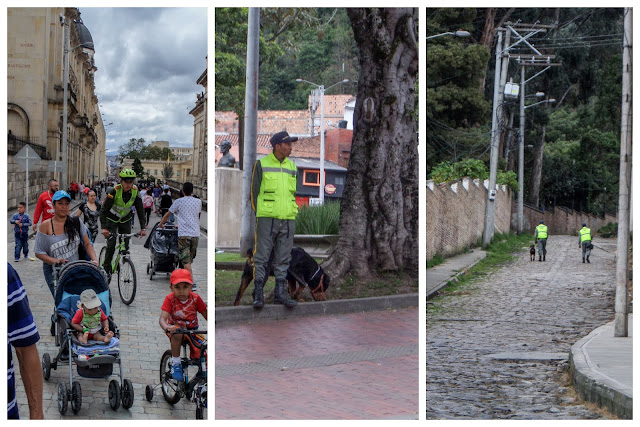Friday, Jan. 20, we took "una camionetta" (a van) from Medellin to Manizales. Although it's only 200 kms., it took us 5 1/2 hours, due to the often tortuous highway. And it would have taken longer, but for the driver's tactics.
 |
| Yes, passing on a double solid line with a curve coming up. Common place in Colombia! |
There were beautiful and interesting sights along the way, too.
 |
| Wow! Expansive! |
 |
| Tasty looking fruit. |
But nothing as interesting as seeing this man hitching a ride on the back of this truck
 |
| A modern-day hobo? |
.
 |
| And since the truck was pulling into a gas station, I guess the man decided to hop off. |
We finally reached Manizales, and from the bus terminal we took a taxi. It was about a 15 minute ride and cost 8,000 pesos (only about $4 Canadian).
Recinto del Pensamiento
We only had two days in Manizales, and on Saturday we went to Recinto del Pensamiento, a nature reserve not far from our hotel. We opted to pay the extra $3 and ride the chair-lift up for the tour, and we were glad we did, as there was a beautiful view from there.
 |
| And the chair-lift went slowly so we could enjoy the view. |

We then had a guided tour, in Spanish, but we were lucky to have a 14 year-old girl in our group who spoke excellent English translate for us. (She goes to a private school; she says the kids in the public schools probably don't learn English as well.)
We really enjoyed the park, for the beautiful flowers,

the hummingbirds in the Mirador de las Aves

the butterflies in the Observatorio
 |
| A glass-winged butterfly |
And the trails through the different forests, Asian, tropical, and cloud forest.
 |
| Vine city! |
La Catedral Basilica de Nuestra Señora del Rosario de Manizales
After the tour through the park, we took a couple of different buses to reach La Catedral in El Centro of Manizales. The cathedral is the third tallest in South America at 113 meters, and has withstood three earthquakes. It was begun in 1929 and completed 30 years later. We found out, though, that in order to climb the stairs that go almost to the top of the spire, you had to take a 75 minute tour, in Spanish. Susann and Christa opted out, so I joined a group of about 10 Colombians and off we went on the tour. And was I ever glad I did!
 |
| Looking down into the Basilica on the way up. |
 |
| Manizales is a city of about 400,000, spreading up the hills that surround it. |
 |
| Looking down, way down! |
 |
| "Hey hey, good lookin'!" |
 |
Whoa! You don't want to go down these stairs too quickly!
|
 |
The stairs run inside the spire and then you take a vertigo-inducing set of stairs on the outside.

A nice view of the Basilica on the descent.

And wonderful stained glass.
The next day, I returned to the cathedral at dusk to capture it being illuminated at twilight.
Lots of tour buses stopping, but other than that a quiet plaza.
Hacienda Venecia Coffee Tour and Tasting
On Sunday we had a coffee plantation tour. We started off with a one-hour explanation of the history of coffee cultivation, along with, of course, a cup of delicious expresso. We then went on a tour of the plantation. (It's actually difficult to get a good cup of coffee in Colombia, because most of the top-grade coffee is exported.)
They prune the coffee plants to keep them at a manageable size for picking by hand.
Because of global warming, the hacienda is having to diversify - at lower elevations, where it's now too warm for ideal coffee-growing conditions, they are planting banana trees. The ones behind Susann are only 7 months old!

They do a lot of hand sorting, sorting the beans according to color and density.

This machine also helps sort the beans.
The coffee plants are started in the nursery before being planted in the plantation.
The Manizales Gondola
Manizales is a hilly city, and roads twist and turn around the hills. So, in 2009, the city opened its Cable in order to provide quick and inexpensive transportation between key points in the city. As in Medellin, the Cable has not only become a panacea for its transportation woes, but has become a key tourist draw as well.

The cable that I took is 2.1 km long and connects the city center with the bus terminal. It was a smooth, scenic ride, and for only about $1.50.
Hills, as far as the eye can see. There are actually three snow-capped mountains that are visible on clear days.
Interesting slides down below!
And the sun sets on another great day on our journey through this wonderful country.
|






















































